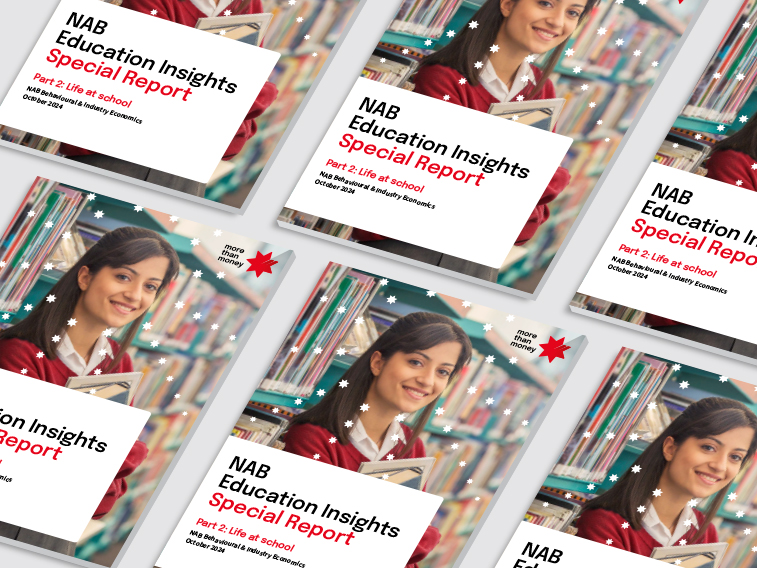How do students feel about life at school? Download the report to find out more.


Insight
Political risks and uncertainty may be on the rise. But a recent tour of Asia for the NAB Asian Debt Capital Markets Conference reminded NAB Global Head of Research Peter Jolly of the many causes for optimism about Australia’s economy.
Nothing is perfect – but on the whole, things are good. That was my message in a nutshell to the issuers and investors participating in NAB’s recent Asian Debt Capital Markets Conference, many of whom expressed concerns about volatility, and rising global trade and political tensions.
With change sweeping everything from the interest rate environment to US-North Korea relations, it’s certainly no time to relax. That said, it’s also important to take a step back and focus on fundamentals. The broad arc of the global economy is positive. We see GDP growth exceeding the 20-year average of 3.5 percent this year and next. Manufacturing activity (as measured by purchasing managers indexes) remains high in major markets like the US and China. Commodities prices are rising, as are China-bound exports of Australian resources like LNG and iron ore.
For Australia, the positive news doesn’t end there. Business conditions are on the upswing and low wage growth and inflation are likely to temper any interest rate rises. The labour market is tightening and unemployment is expected to decline further as cities work to support population growth. Even weaker sectors such as retail are performing relatively well, and there are several sectors that are well placed to serve as major engines of growth in future, namely:
Infrastructure. Put simply, infrastructure has yet to catch up with the massive and ongoing growth in the country’s population, which is most evident in major urban areas. In Melbourne alone, the population expanded by 23 percent, or nearly 1 million, from 2006 to 2016. This represents a significant challenge for builders, planners and public services, but also means infrastructure has significant room to grow, and bodes well for the labour market. There’s been a spike in infrastructure investment in recent years; in Victoria, Queensland and New South Wales transport projects under construction now account for over 5 percent of gross state product. These projects are likely to help generate further growth as they come online and create new business and residential hubs.
Property. There are worries in some segments of the market, and the outlook for some cities, notably Melbourne and Canberra, is better than others, like Darwin and Perth. Nonetheless property is a supply-demand story at heart, and the rapidly expanding population and broadly favourable economic conditions should ensure demand remains robust overall. Barring an unlikely shock like a massive spike in interest rates or the collapse of the Chinese economy, we expect prices to remain relatively stable.
Education and tourism. Resources tend to capture all the attention, but these industries could be viewed as the unsung heroes of the economy. Education is now Australia’s third-largest export industry and continues to post impressive growth, with enrolments by both Chinese and Indian students in higher education rising by double digits last year. Tourism is also very strong thanks to China, which is our number one source of short-term arrivals.
Based on the solid economic outlook, as well as factors like interest rate differentials and commodity price trends, we believe the fair value for the Australian dollar versus the US dollar is in the 0.78 range – in other words, not that far from where it is now.
It should be clear by now that I’m an optimist, but there are also issues that should be watched closely. A General Election will be held in late 2018 or the 1st half of 2019 and investors should be aware there is a greater differentiation in the policies of the Government and the alternative Labor party. There’s also a possibility credit conditions will tighten, depending on the central bank’s moves and other factors. However overall it’s external shocks, rather than internal issues, that Australia needs to look out for.
My interactions with Asian investors at our recent DCM conference was a good reminder of the many other reasons for confidence in Australia. We’re positioned in the most dynamic region in the planet. Our connections with the rest of Asia Pacific are well-established, deep and multiplying, in part because what we offer is so well-aligned with the needs and aspirations of Asian investors and consumers. That’s true whether it’s our strong tradition of governance; our world-class education system; or our growing focus on sustainability in energy and infrastructure, which ties in perfectly to rising demand for sustainable assets. Perfection is a lot to ask for – but in some respects, what we have is pretty close.
© National Australia Bank Limited. ABN 12 004 044 937 AFSL and Australian Credit Licence 230686.